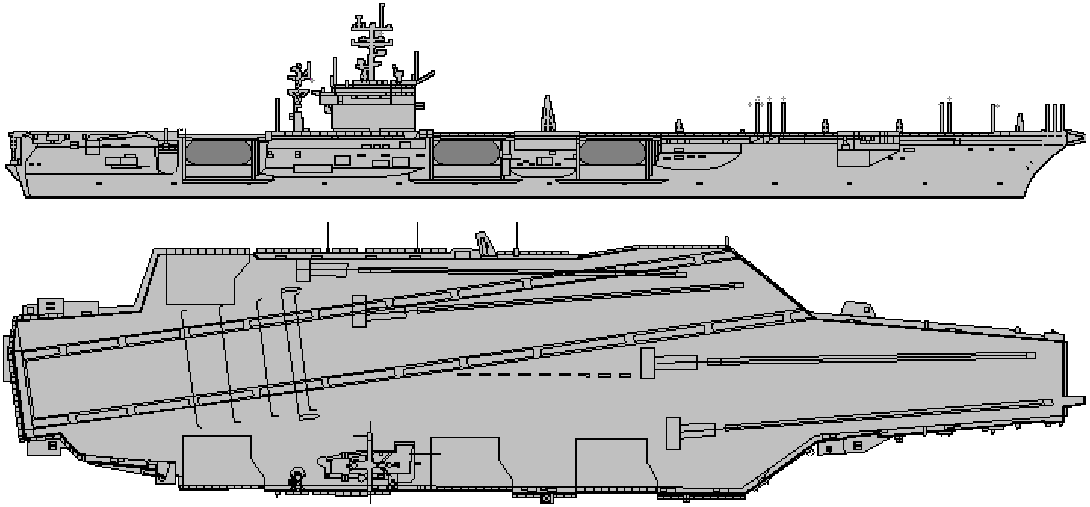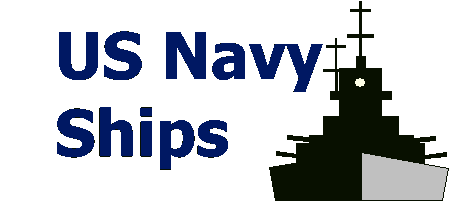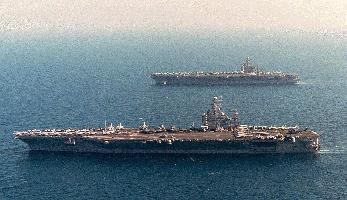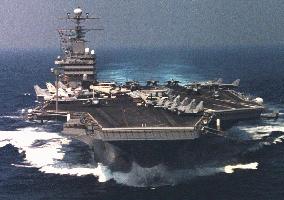




The carrier air wing can destroy enemy aircraft, ships, submarines, and land targets, or lay mines hundreds of miles from the ship. Aircraft are used to conduct strikes, support land battles, protect the battle group or other friendly shipping, implement a sea or air blockade. The air wing provides a visible presence to demonstrate American power and resolve in a crisis. The ship normally operates as the centerpiece of a carrier battle group commanded by a flag officer embarked in the carrier and consisting of four to six other ships, including guided missile cruisers, destroyers, frigates, replenishment ships and submarines.
The NIMITZ-class carriers are a floating airport, capable of launching as many as four aircraft a minute. The ship's four catapults and four arresting gear engines enable her to launch and recover aircraft rapidly and simultaneously. The ships carry seven different types of aircraft with a total complement of more than 80 planes. During flight operations, the flight deck of 4.5 acres is a scene of intense activity, with crew, aircraft and other equipment functioning as a well-rehearsed and carefully choreographed team to ensure both efficiency and safety. Four aircraft elevators, each the size of two average city lots, bring the aircraft to the flight deck from the hangars below. Small tractors spot the planes on the flight deck. Aviation fuel is pumped up from tanks below, and bombs and rockets are brought up from the magazines. Powerful steam catapults (affectionately known as "Fat Cats") can accelerate 37-ton jets from zero to a safe flight speed of up to 180 miles per hour in about 300 feet and in less than three seconds. The weight of each aircraft determines the amount of thrust provided by the catapult. When landing, pilots use a system of lenses to guide the aircraft "down the slope," the correct glide path for landing. The four arresting wires, each consisting of two-inch thick wire cables connected to hydraulic rams below decks, drag landing aircraft going as fast as 150 miles per hour to a stop in less than 400 feet. High in the island, seven stories above the flight deck, the "Air Boss" and his staff coordinate the entire operation, which is carefully monitored from the flight deck level as well as by the Captain on the ship's bridge. The various functions of the flight deck crew are identified by the colors they wear: yellow for officers and aircraft directors; purple for fuel handlers; green for catapult and arresting gear crews; blue for tractor drivers; brown for chock and chain runners; and red for crash and salvage teams and the ordnance handlers. The NIMITZ-class self-defense measures include: missiles, guns, and electronic warfare. The NATO Sea Sparrow Missile System is comprised of two launchers with eight missiles each. Sea Sparrow is a radar-guided, short-to-medium range missile capable of engaging aircraft and cruise missiles. NIMITZ-class also has Close-In Weapon System mounts for short range defense against aircraft or missiles. Each mount has its own search and track radar, and a six-barrel, 20-millimeter Gatling gun capable of firing 3,000 rounds per minuteThe carrier's two nuclear reactors give her virtually unlimited range and endurance and a top speed in excess of 30 knots. Eight steam turbine generators each produce 8,000 kilowatts of electrical power, enough to serve a small city. The ship has enough electrical generating power to supply electricity to a city of 100,000. The ships normally carrys enough food and supplies to operate for 90 days. Four distilling units enable NIMITZ-class engineers to make over 400,000 gallons of fresh water from seawater a day, for use by the propulsion plants, catapults and crew. The ship carries approximately 3 million gallons of fuel for her aircraft and escorts, and enough weapons and stores for extended operations without replenishment. These ships also have extensive repair capabilities, including a fully equipped Aircraft Intermediate Maintenance Department, a micro-miniature electronics repair shop, and numerous ship repair shops. Keeping a NIMITZ-class carrier ready at all times requires repair shops to maintain machinery and aircraft, heavy duty tailor shops to repair parachutes and other survival gear, and electronic ships that keep communication, navigation and avionics equipment in good condition. NIMITZ-class carriers boast all the amenities that would be found in any American city with a comparable population, including a post office with its own ZIP code, TV and radio stations, a newspaper, a fire department, a library, a hospital, a general store, two barbershops and much more.
USS Theodore Roosevelt (CVN 71) departed Newport News Shipbuilding (NYSE: NNS) on July 2, 1998 after a year-long period of maintenance and overhaul work. The ship returned to its homeport in Norfolk, Va. Work performed on Roosevelt included the replacement of all four ship propellers, blasting and painting of the hull, major renovations of onboard storage tanks and miscellaneous systems upgrades.The USS Abraham Lincoln (CVN 72) joined the fleet in 1990 as, concurrently, USS Coral Sea (CV 43) was decommissioned. USS Abraham Lincoln underwent a one-year comprehensive overhaul and a change of homeport from Alameida, Calif. to Everett, Wash. since its last major deployment in 1995. On 11 June 1998 USS Abraham Lincoln (CVN-72) departed Naval Station Everett to the Arabian Gulf and back over a six-month period, the ship's fourth major Western Pacific deployment.
CVN 73, 74 and 75 were authorized to replace conventionally powered carriers as they retired in the 1990s. The Congress authorized full funding in 1988 for CVN 74 and 75. These ships are modified repeats of CVN 73.The keel of USS Harry S. Truman was laid 29 November 1993 and the ship was christened at Newport News on 07 September 1996. Harry S Truman (CVN 75) completed acceptance sea trials on 24 June 1998, was delivered to the US Navy a few days later. The ship was commissioned and put into active service on 25 July 1998 at the Norfolk Naval Base in Norfolk, VA. At that time, the Navy's oldest active commissioned ship, Independence (CV 62), transitioned to the inactive fleet. CVN 76's keel has been laid for a 2002 delivery, and CVN 77 will enter the fleet in 2008, as the two remaining Kitty Hawk-class carriers are retired. CVN 77 will act as a transition ship toward CVX, incorporating numerous new technologies and process design changes that will move naval aviation to a future carrier design.
Technological improvements will begin to be seen in CVN-76 RONALD REAGAN, which will be commissioned in 2002. REAGAN will have a redesigned bulbous bow for increased propulsion efficiency and trim stability. Her aircraft elevators will also have greater capacity then those currently in use aboard her sister ships. According to studies conducted by the Newport News Shipbuilding Carrier Innovation Center, one possibility evaluated would be to remove elevator number one (on the starboard side, near the bow catapults) and simply make it part of the flight deck. Elevators two and three would be widened and strengthened to handle up to three aircraft. This would vastly improve aircraft operating efficiency. According to Rear Admiral Alfred G. Harms, Commander, Carrier Group Three, the number one elevator is…"rarely used. Particularly at night because of the safety considerations." This improved flight deck layout would increase air operations safety as well as the ship’s sortie rate. As a modified repeat of USS HARRY S. TRUMAN (CVN-75), REAGAN will provide an important step on the road to CVNX.
The Navy plans 33-month nuclear refueling Refueling Complex Overhauls for its Nimitz-class carriers beginning with the USS Nimitz in fiscal year 1998. On 01 May 1998 Newport News Shipbuilding was awarded a contract by the U. S. Navy to perform refueling and overhaul work on the USS Nimitz (CVN 68). The contract, valued at approximately $1.2 billion, was signed by Navy and Newport News Shipbuilding officials on April 30, 1998. Nimitz, the lead ship of the class, is also the first of its class to undergo this major life-cycle milestone. The ship will arrive in late May 1998 and the work performance period is scheduled to last approximately 33 months. In addition to the refueling of both of the ship’s reactors, there will be significant modernization work. This includes a major upgrade of the island house that will involve the shipyard removing the top two levels of the island house and replacing them. This action is driven by the installation of a new antenna mast that runs down along the island and will provide for better radar capabilities. The shipyard is also integrating a new radar tower aboard Nimitz. The Navy elected to overhaul the Nimitz without adding cooperative engagement, integrated ship self defense, the advanced combat direction system, the rolling airframe missile, the SPQ 9 navigation radar, a common high-band data link, the battlegroup passive horizon extension system, an outboard weapons elevator, conversion of nuclear magazines, emergency ordnance handling, and improved propellers. More than 3,200 Newport News Shipbuilding employees will be working aboard Nimitz during peak periods of the overhaul and refueling project.The second overhaul is scheduled for fiscal year 2001, and the third is projected to begin about fiscal year 2005. The overhaul of the Dwight D. Eisenhower (CVN 69), scheduled for 2000, will be the ship's first and only refueling during a service-life expected to span approximately 50 years. On 12 February 1999 Newport News Shipbuilding was awarded a $169,790,050 modification to previously awarded contract for the FY 99 advance planning of the refueling and complex overhaul of Dwight D. Eisenhower (CVN 69) and its reactor plants. Eisenhower is scheduled to arrive at Newport News in late 2000 and remain for approximately three years. Other Nimitz-class carriers will follow so that a carrier will be in a shipyard undergoing a nuclear refueling overhaul for about the next 30 years, with the exception of about 4 years during this period.
The 1993 decision to close Naval Air Station Alameda, Ca. made it necessary to develop the facilities and infrastructure to accommodate one NIMITZ-class aircraft carrier in San Diego. The USS John C. Stennis (CVN 74) is expected to arrive in San Diego in 1998. This will be in addition to the two conventionally-powered aircraft carriers, USS Kitty Hawk (CV 63) and USS Constellation (CV 64), presently homeported there. The nuclear-powered NIMITZ-class aircraft carrier is a much larger and deeper draft ship than its steam-driven predecessors. Thus, the dredging of the berthing areas, turning basin and the access channel adjacent to NAS North Island is necessary. Aircraft carriers are generally estimated to have useful operating lives of 50 years.Specifications | |
| Builder | Newport News Shipbuilding Co., Newport News, Va. |
| Power Plant | Two Nuclear Power Plant (A4W Pressurized Water Reactor) Four shafts, Four propellers, with five blades each |
| Length, overall | 1,092 feet (332.85 meters) |
| Flight Deck Width | 252 feet (76.8 meters) |
| Beam | 134 feet (40.84 meters) |
| Displacement | Approx. 97,000 tons (87,300 metric tons) full load |
| Speed | 30+ knots (34.5+ miles per hour) |
| Aircraft | 85 |
| Aircraft elevators | Four |
| Catapults | Four |
| Crew | Ship's Company: 3,200 Air Wing: 2,480 |
| Armament |
4 Sea Sparrow launchers 3 Phalanx CIWS 20mm mounts [Nimitz & Ike] 4 Phalanx CIWS 20mm mounts [Vinson and later] |
| Combat Systems |
SPS-48E 3-D air search radar SPS-49(V)5 2-D air search radar 3 Mk91 Fire Control AN/SLQ-32(V)4 active jamming/deception AN/WLR-1H ESM |
| Service Life | 50 years |
| Unit Operating Cost Annual Average | ~$160,000,000 [source: [FY1996 VAMOSC] |
|
Total Costs [$millions constant $FY97] |
Investment cost
Ship acquisition cost $ 4,059
Midlife modernization cost $ 2,382
Total investment cost $ 6,441
Average annual investment cost $ 129
Operating and support cost
Direct operating and support cost $11,677
Indirect operating and support cost $ 3,205
Total operating and support cost $14,882
Average annual operating and support cost $ 298
Inactivation/disposal cost
Inactivation/disposal cost $ 887
Spent nuclear fuel storage cost $ 13
Total inactivation/disposal cost $ 899
Average annual inactivation/disposal cost $ 18
|
Ships | ||||||
| Name | Number | Builder | Homeport | Ordered | Commissioned | Stricken |
| Nimitz | CVN-68 | Newport News | Norfolk | 31 Mar 1967 | 03 May 1975 | 2025 |
| Dwight D. Eisenhower | CVN-69 | Newport News | Norfolk | 29 Jun 1970 | 18 Oct 1977 | 2027 |
| Carl Vinson | CVN 70 | Newport News | Bremerton | 05 Apr 1974 | 13 Mar 1982 | 2032 |
| Theodore Roosevelt | CVN-71 | Newport News | Norfolk | 30 Sep 1980 | 25 Oct 1986 | 2036 |
| Abraham Lincoln | CVN 72 | Newport News | Everett | 27 Dec 1982 | 11 Nov 1989 | 2039 |
| George Washington | CVN 73 | Newport News | Norfolk | 27 Dec 1982 | 04 Jul 1992 | 2042 |
| John C. Stennis | CVN-74 | Newport News | San Diego | 30 Jun 1988 | 09 Dec 1995 | 2045 |
| Harry S. Truman [ex United States] | CVN-75 | Newport News | Norfolk | 30 Jun 1988 | 25 Jul 1998 | 2048 |
| Ronald Reagan | CVN-76 | Newport News | San Diego | 08 Dec 1994 | 2002 | 2052 |
| CVN-77 | Newport News | building | 03 Sep 1998 | 2008 | 2058 | |


